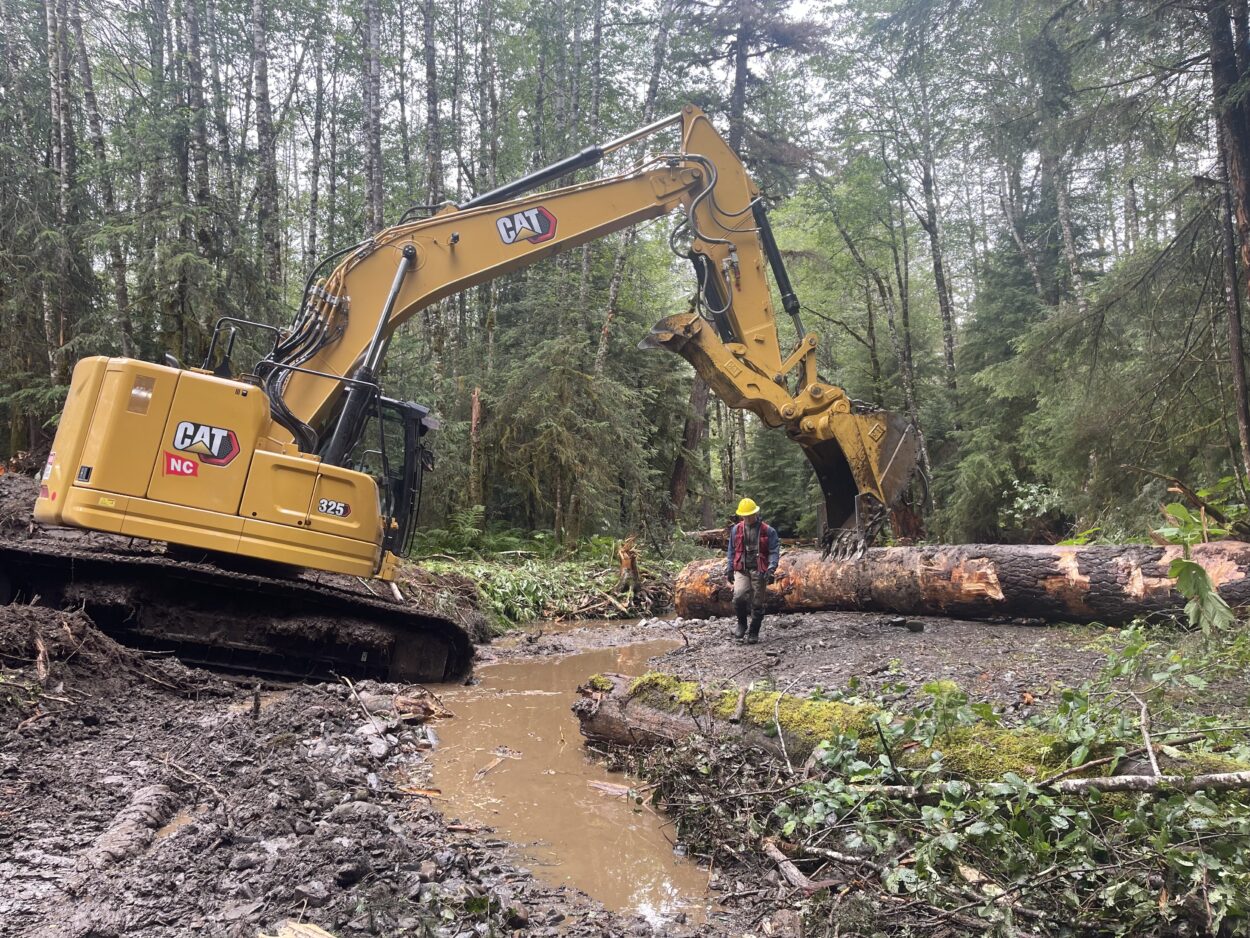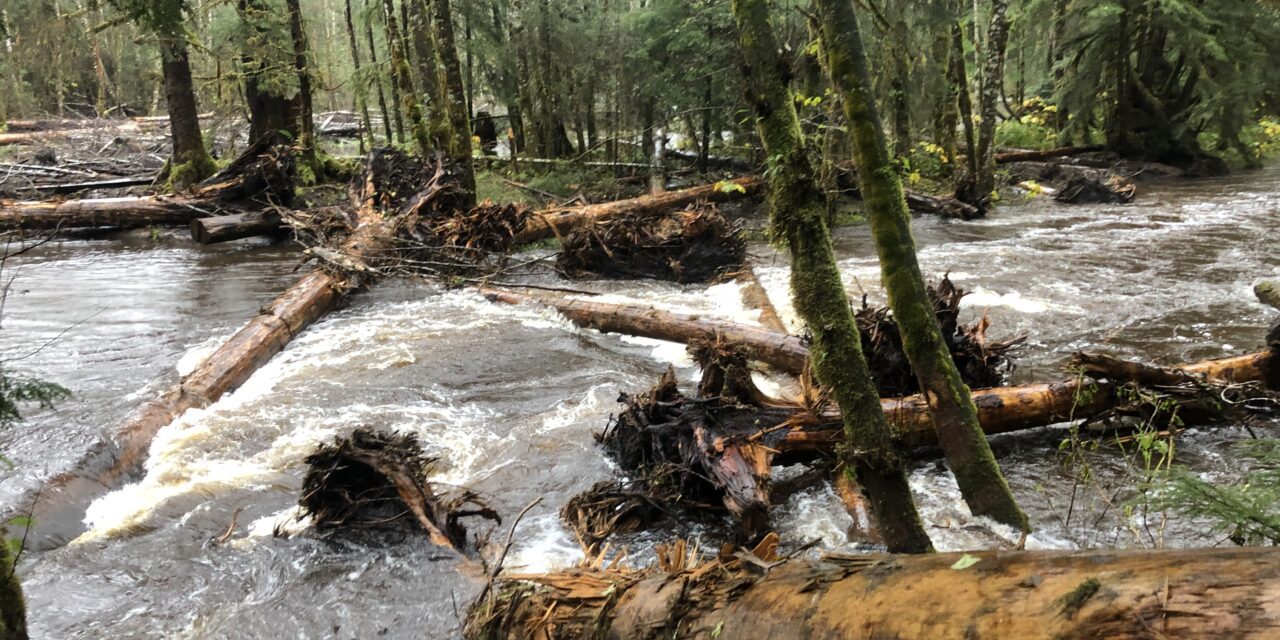The Petersburg Marine Mammal Center has resurrected its monthly seminar program after a two-year hiatus due to the pandemic. Late last month, the center invited a hydrologist from the Petersburg Ranger District up to the stage. Heath Whitacre spent the last few years restoring regional watersheds. He presented on how his team is saving streams from mistakes made in the agency’s past.
The conference room of the Petersburg Public Library was packed with local residents of all ages on January 26th, eager to learn about salmon on a Thursday night. There were scatterings of inside experts: some biologists, as well as some U.S. Forest Service employees still wearing their fatigues. But they’re outnumbered by students from Petersburg Middle School who are there to collect extra credit points. Whitacre began his talk with a question.
“What might happen, that we need to restore a stream?” asked Heath Whitacre.
“Maybe if you get trees or things that fall into the river, making it harder for fish to live in it?” an audience member replied.
“That’s right on the money,” said Whitacre.
Whitacre explained that the Forest Service had the same idea decades ago. But by removing those trees, they made a grave mistake.
“We actually had some active stream-cleaning projects starting in the 60s and moving into the early 70s,” said Whitacre. “The Forest Service and the Alaska Department of Fish and Game had projects where they would actively remove wood from the channels in this mistaken belief that they were helping salmon transit through those areas up to their spawning grounds easier. We know better now.”
The logs these agencies cleared were actually part of the architecture of the stream. Removing them had a cascading negative effect that Tongass ecosystems still feel today.
“Those streams were in the worst shape out of any streams I’ve seen,” said Whitacre. “The ones that have actively had wood pulled out. Some of the conditions are common: simplified habitat, the lack of pools, and excessive erosion on certain portions of the stream.”

Healthy waterways in the forest are essential spawning habitat for the region’s salmon. In the audience, long-time Petersburg resident Grant Trask reflected on another instance of federal infrastructure projects harming Tongass salmon habitat in the 60s and 70s.
“We call this place up the road Man-Made Hole,” said Trask. “You guys know the reason for it? The State of Alaska came into being in 1968. The Department of Transportation — one of the things they wanted to do was to expand roads. And so here on Mitkof Highway, they were extending it out to where it stops now, but they needed to borrow some gravel on the floodplain. But this is the worst example: they were taking gravel out of this particular spot. And there were salmon eggs all over. By the time they had that gravel laid out on top of the riprap, you can see the reddish color for all the salmon eggs on the surface of the Mitkof highway. So that’s pretty grim.”
Trask worked for the Forest Service around that time, then fished for nearly 40 years. That’s why, he said, he takes threats to salmon personally. Today, Whitacre says his team has settled into the work of cleaning up the previous cohort’s mess: by re-cluttering salmon habitat.
“It’s like putting your thumb on the end of a hose, right?” said Whitacre. “That water speeds up the velocity. You get more power. And so just the opposite of that — changing the dimension and getting wider — you lose power, right?”
Less power causes creeks to “pan out.” Whitacre clicks through slides of streams so shallow, they barely tumble over the smallest rocks in the riverbed. The debris is the key. Felled trees create pools where salmon can lay their eggs. They also help regulate water temperature and speed — unobstructed waterways are weaker and warmer than ones with trees in them. Whitacre says studies show that salmon that grow up in these cool oxygenated waters — like those created by beaver dams — are bigger by an order of magnitude than farm-raised salmon.
“A lot of times that’s probably the most stressful time for a salmon is that higher-temperature, low water,” said Whitacre. “And I guarantee they’re gonna be hanging out in the deepest pool they can find.”
Restoration projects like these can be very expensive, requiring heavy equipment and occasionally even helicopters to adjust trees in the river.
“It’s a lot,” says Whitacre. “But, you know, that’s Mother Nature. And I think anytime that we think that we’re going to improve on Mother Nature, we need to give the salmon a heads up.”
Contracts cost anywhere from hundreds of thousands to millions of dollars. But the Forest Service doesn’t budget for these projects like they used to. While the agency still provides environmental assessments for these projects, Whitacre says the team relies on nonprofit partners like Trout Unlimited and the Nature Conservancy to fund their work. Whitacre’s team is currently planning a watershed restoration project on Prince of Wales Island. The project is large-scale and will involve the use of heavy equipment.










